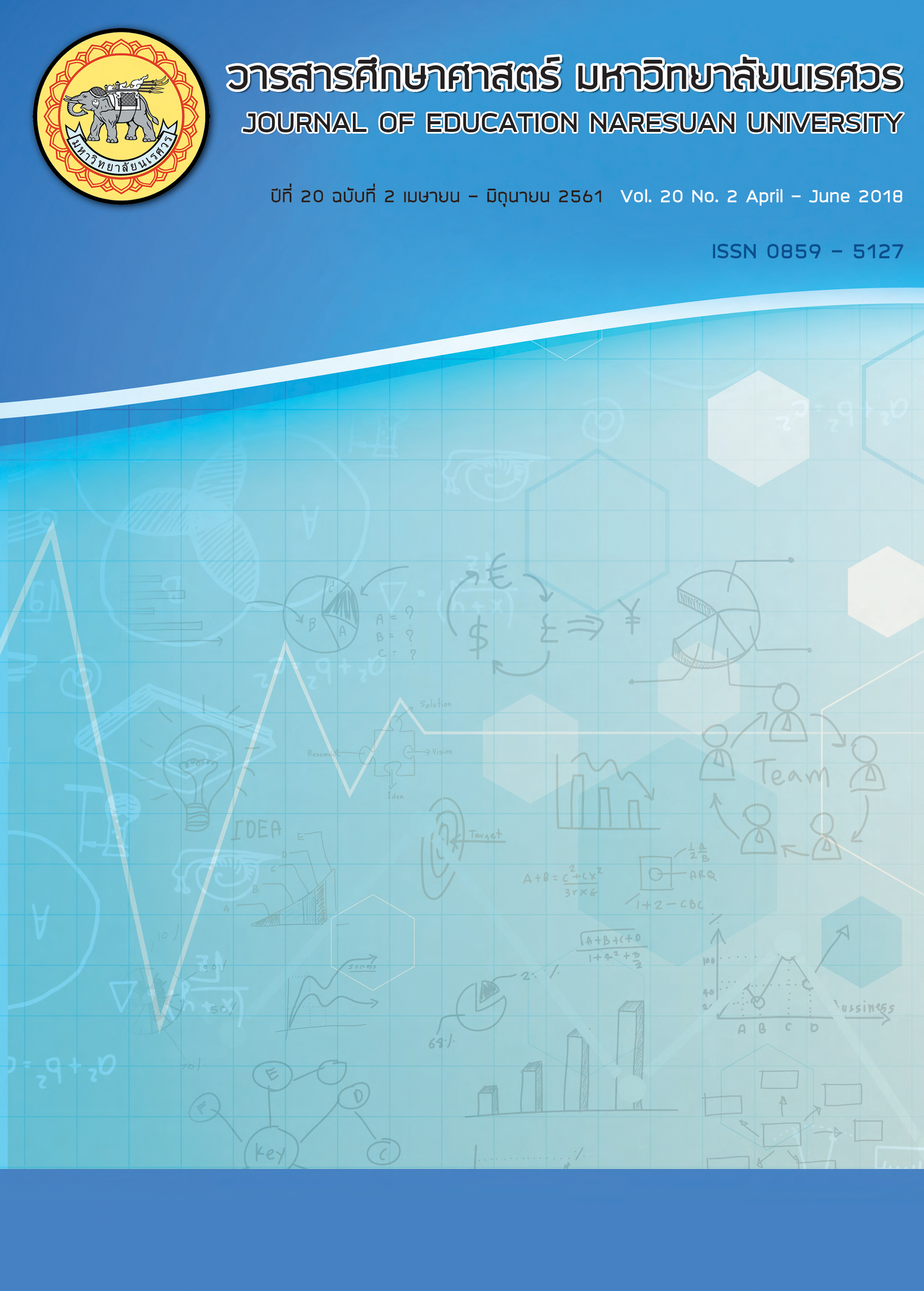ผลการจัดกิจกรรมการเรียนรู้ตามรูปแบบการสอนมโนทัศน์ที่มีต่อมโนทัศน์ทางคณิตศาสตร์ เรื่อง ตัวหารร่วมมากและตัวคูณร่วมน้อย ของนักเรียนชั้นมัธยมศึกษาปีที่ 1; THE EFFECT OF LEARNING ACTIVITY MANAGEMENT IN THE LINE OF CONCEPT ATTAINMENT MODEL...
Main Article Content
Abstract
การวิจัยครั้งนี้มีจุดมุ่งหมาย คือ 1) เพื่อเปรียบเทียบมโนทัศน์ทางคณิตศาสตร์ระหว่างก่อนเรียนและหลังเรียน เรื่อง ตัวหารร่วมมากและตัวคูณร่วมน้อย ของนักเรียนชั้นมัธยมศึกษาปีที่ 1 ที่ได้รับการจัดกิจกรรมการเรียนรู้ตามรูปแบบการสอนมโนทัศน์ และ 2) เพื่อเปรียบเทียบมโนทัศน์ทางคณิตศาสตร์ เรื่อง ตัวหารร่วมมากและตัวคูณร่วมน้อย ของนักเรียนชั้นมัธยมศึกษาปีที่ 1 ที่ได้รับการจัดกิจกรรมการเรียนรู้ตามรูปแบบการสอนมโนทัศน์กับเกณฑ์ร้อยละ 70 กลุ่มตัวอย่าง คือ นักเรียนชั้นมัธยมศึกษาปีที่ 1/2 ภาคเรียนที่ 2 ปีการศึกษา 2558 โรงเรียนอุดมดรุณี จำนวน 36 คน เครื่องมือที่ใช้ในการวิจัย คือ แผนการจัดกิจกรรมการเรียนรู้ตามรูปแบบการสอนมโนทัศน์ เรื่อง ตัวหารร่วมมากและตัวคูณร่วมน้อย และแบบทดสอบวัดมโนทัศน์ทางคณิตศาสตร์ เรื่อง ตัวหารร่วมมากและตัวคูณร่วมน้อย แผนการวิจัย คือ One Group Pretest-Posttest Design วิเคราะห์ข้อมูลด้วยค่ามัชฌิมเลขคณิต ค่ามัชฌิมเลขคณิตร้อยละ ส่วนเบี่ยงเบนมาตรฐาน และการทดสอบค่าที (t-test) ผลการวิจัย พบว่า 1) นักเรียนชั้นมัธยมศึกษาปีที่ 1 ที่ได้รับการจัดกิจกรรมการเรียนรู้ตามรูปแบบการสอนมโนทัศน์ มีมโนทัศน์ทางคณิตศาสตร์ เรื่อง ตัวหารร่วมมากและตัวคูณร่วมน้อย หลังเรียนสูงกว่าก่อนเรียนอย่างมีนัยสำคัญทางสถิติที่ระดับ 05 2) นักเรียนชั้นมัธยมศึกษาปีที่ 1 ที่ได้รับการจัดกิจกรรมการเรียนรู้ตามรูปแบบการสอนมโนทัศน์ มีมโนทัศน์ทางคณิตศาสตร์ เรื่อง ตัวหารร่วมมากและตัวคูณร่วมน้อย คิดเป็น 74.86 ซึ่งสูงกว่าเกณฑ์ร้อยละ 70 อย่างมีนัยสำคัญทางสถิติที่ระดับ .05
THE EFFECT OF LEARNING ACTIVITY MANAGEMENT IN THE LINE OF CONCEPT ATTAINMENT MODEL TO MATHEMATICS CONCEPT ON THE TOPIC OF HIGHEST COMMON FACTOR AND LEAST COMMON MULTIPLE OF GRADE VII STUDENTS
The purposes of this research were 1) to compare the mathematics concept before and after learning of grade VII students on the topic of highest common factor and least common multiple after learning activity management in the line of Concept Attainment Model, and 2) to compare the mathematics concept of grade VII students on the topic of highest common factor and least common multiple after learning activity management in the line of Concept Attainment Model with the determined criteria of 70 percent of the test score. The sample group was 36 students in the grade VII, second semester, academic year 2015 at Udomdarunee School. The research instrument were the lesson plans activity management in the line of Concept Attainment Model on the topic of highest common factor and least common multiple and mathematics concept test on the topic of highest common factor and least common multiple. The research was One Group Pretest-Posttest Design. The data were analyzed by mean of arithmetic means, means of percentage, standard deviation, and t-test for one sample. The results of the study revealed that 1) mathematics concept of grade VII students after learning activity management in the line of Concept Attainment Model on the topic of highest common factor and least common multiple was higher than before learning at .05 level of statistical significance, and 2) mathematics concept of grade VII students after learning activity management in the line of Concept Attainment Model on the topic of highest common factor and least common multiple were 74.86 which higher than the determined criteria of 70 percent of the test score at .05 level of statistical significance.
Article Details
The owner of the article does not copy or violate any of its copyright. If any copyright infringement occurs or prosecution, in any case, the Editorial Board is not involved in all the rights to the owner of the article to be performed.
References
Joyce, B., & Weil, M. (1996). Models of teaching (4th ed.). Boston: Allyn and Bacon.
Luanpan, O. (2012). The study of effects in organizing mathematics activities by using
a concept attainment model on mathematical concepts and learning retention on "Sequence and Series" of Mathayomsuksa Five Students at Wat Prasrimahadhad Secondary Demonstration School, Bangkok (Master thesis). Bangkok: Kasetsart University. (in Thai)
Makanong, A. (2003). Mathematics: teaching and learning. Bangkok: Chulalongkorn University. (in Thai)
Makanong, A. (2004). Teaching document of theory and applications in mathematics education subject. Bangkok: Chulalongkorn University. (in Thai)
Makanong, A. (2009). Development of mathematics concept using the concept attainment model and higher order questions (Research report). Bangkok: Chulalongkorn University. (in Thai)
Ministry of Education. (2008). The Basic Education Core Curriculum B.E. 2551 (A.D. 2008). Bangkok: The Agricultural Cooperative Federation of Thailand. (in Thai)
Pilanthananond, N. (1999). Concept learning. Bangkok: Kasetsart University. (in Thai)
Pornphawitkul, P. (2006). Effects of using a concept formation model in organizing mathematics activities on mathematical concepts and learning retention of fifth grade students in Bangkok (Master thesis). Bangkok: Chulalongkorn University. (in Thai)
Ra-Ngubtook, W. (2002). Learner centered techniques and learning activities according to Basic education curriculum B.E. 2544. Bangkok: Suweeriyasarn. (in Thai)
Saiyod, L., & Saiyod, A. (1995). Measurement and evaluation learning techniques. Bangkok: Suweeriyasarn. (in Thai)
The National Institute of Educational Testing Service (Public Organization). (2015). Exam information. Retrieved May 20, 2015, from https://www.niets.or.th (in Thai)

